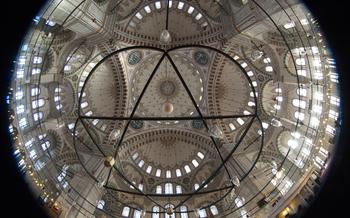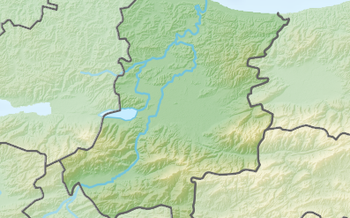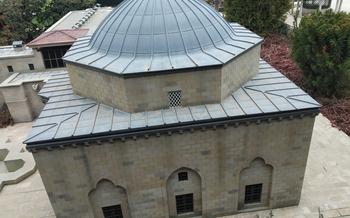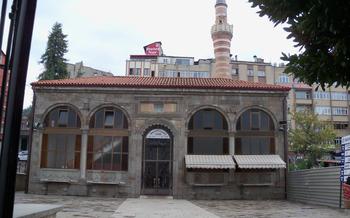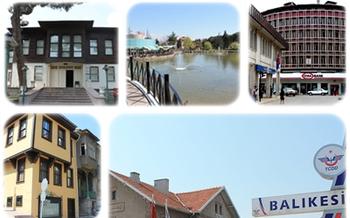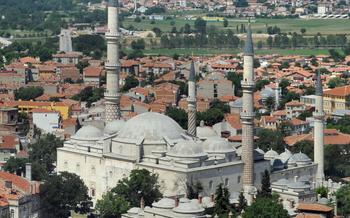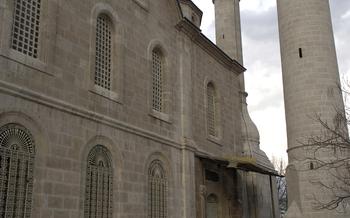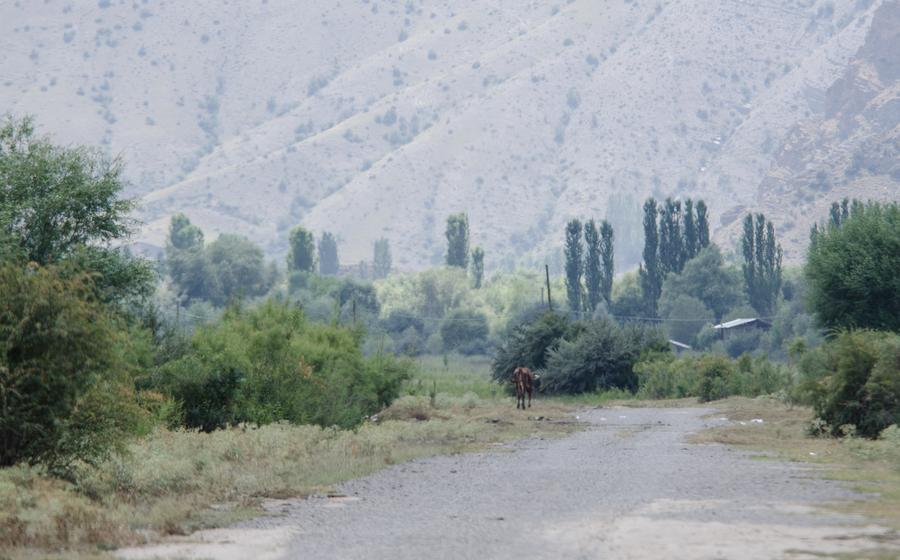
Mecidiye Mosque
- Mecidiye Mosque: An Architectural Masterpiece
- Must-See Highlights
- Location and Accessibility
- Exploring the Grand Interior
- Historical Context and Symbolism
- Significance in Islamic Architecture
- A Place of Worship and Community
- Tips for a Rewarding Visit
- Mesmerizing Exterior Design
- A Journey Through Time
- Insider's Perspective: Local Stories and Legends
- Symbol of Cultural Exchange
- Experiencing the Call to Prayer
- Exploring the Neighborhood
- A Place of Peace and Reflection
- Preservation and Restoration Efforts
- Insider Tip: Unveiling Hidden Details
Mecidiye Mosque: An Architectural Masterpiece
The Mecidiye Mosque stands as a testament to the grandeur and architectural prowess of the Ottoman Empire. Its construction was commissioned by Sultan Abdülmecid I in 1853 and completed in 186The mosque, designed by renowned architect Kirkor Balyan, is an exquisite blend of Ottoman and Byzantine architectural styles, creating a unique and breathtaking structure.
Situated in the heart of Erzurum, the Mecidiye Mosque is a prominent landmark that dominates the city's skyline. Its strategic location on a hilltop allows for panoramic views of the surrounding mountains and valleys, making it a popular destination for both local residents and tourists alike. The mosque's accessibility is further enhanced by its proximity to the city center, ensuring that visitors can easily incorporate it into their itinerary when exploring Erzurum.
Must-See Highlights
The Mecidiye Mosque boasts several must-see highlights that captivate visitors with their beauty and intricate craftsmanship. The grand dome, adorned with colorful tiles and intricate patterns, is a focal point that commands attention. The interior is illuminated by a series of magnificent chandeliers, adding to the mosque's ambiance and creating a sense of awe and wonder.
The mihrab, the niche indicating the direction of Mecca, is a masterpiece of Islamic art, featuring intricate carvings, calligraphy, and colorful tiles. The minbar, or pulpit, is another exquisite feature, showcasing fine woodwork and delicate carvings that enhance the mosque's overall aesthetic appeal.
Location and Accessibility
The Mecidiye Mosque enjoys a prime location in the heart of Erzurum, making it easily accessible for visitors. Situated on a hilltop overlooking the city, it offers panoramic views of the surrounding mountains and valleys. The mosque is within walking distance from the city center, allowing visitors to seamlessly incorporate it into their exploration of Erzurum's historical and cultural attractions.
Exploring the Grand Interior
Step inside the Mecidiye Mosque, and prepare to be awestruck by its awe-inspiring interior. The vast prayer hall is crowned by a magnificent dome that seems to soar towards the heavens. Elaborate chandeliers suspended from the dome cast a warm glow, illuminating the intricate details adorning the mosque's interior.
The mihrab, a niche indicating the direction of Mecca, is a masterpiece of craftsmanship. Its intricate carvings and colorful tiles form a mesmerizing display that draws the eye. The minbar, or pulpit, is equally impressive, featuring delicate carvings and inlaid mother-of-pearl that add to the mosque's opulent ambiance.
The walls and columns are adorned with intricate tilework that narrates stories from the Quran and Islamic history. Each tile is meticulously hand-painted, creating a kaleidoscope of colors and patterns that captivates the senses. Verses from the Quran, written in elegant calligraphy, adorn the walls, adding to the mosque's spiritual ambiance.
The air inside the mosque is filled with a sense of serenity and tranquility. The soft murmur of prayers and the gentle footsteps of worshippers create a peaceful atmosphere that invites contemplation and reflection. The Mecidiye Mosque is a true sanctuary for the soul, where visitors can find solace and connect with their spiritual side.
Historical Context and Symbolism
The Mecidiye Mosque stands as a testament to the grandeur and power of the Ottoman Empire. Its construction, ordered by Sultan Abdülmecid I in the mid-19th century, reflects the empire's architectural prowess and its commitment to Islam. The mosque's design incorporates various architectural influences, including Seljuk and Byzantine elements, showcasing the empire's rich cultural heritage.
As a symbol of Ottoman power and authority, the Mecidiye Mosque served as a central hub for religious and community gatherings. Its strategic location in the heart of Erzurum, a significant city on the eastern frontier of the empire, further emphasized its importance. The mosque's striking architecture, with its towering domes and intricate details, conveyed a message of strength and stability, reinforcing the Ottoman Empire's dominance in the region.
Significance in Islamic Architecture
The Mecidiye Mosque stands as a testament to the grandeur and artistry of Islamic architecture. It is widely regarded as one of Turkey's most prominent mosques and exemplifies the distinctive style of Ottoman mosque architecture. The mosque's unique features and innovative design elements have had a profound influence on subsequent Islamic architecture, both in Turkey and beyond.
One of the most striking aspects of the Mecidiye Mosque is its massive dome, which is supported by four massive pillars. The dome's intricate interior decoration, featuring colorful tiles and intricate calligraphy, is a testament to the skill and artistry of Ottoman craftsmen. The mosque's minarets, which rise majestically from the corners of the building, are another distinctive feature. Their slender, fluted design and intricate tilework add to the mosque's overall grandeur and elegance.
The Mecidiye Mosque also boasts a richly decorated interior, with intricate tilework adorning the walls and mihrab. The mihrab, a niche in the wall indicating the direction of prayer, is particularly noteworthy for its exquisite craftsmanship and use of colorful tiles. The mosque's minbar, or pulpit, is another beautifully crafted element, featuring intricate carvings and inlaid mother-of-pearl.
The Mecidiye Mosque's unique design and innovative features have left a lasting legacy on Islamic architecture. Its influence can be seen in numerous mosques built throughout the Ottoman Empire and beyond, including the famous Blue Mosque in Istanbul. The mosque's enduring significance lies not only in its architectural beauty but also in its role as a symbol of Ottoman power and grandeur.
A Place of Worship and Community
Mecidiye Mosque stands not only as an architectural masterpiece but also as a vibrant center of worship and community for Erzurum's Muslims. Daily prayers and religious observances fill the mosque with a sense of devotion and spirituality. Beyond its role as a place of worship, the mosque serves as a gathering place for community events, fostering a sense of unity and faith among Erzurum's Muslim community. Welcoming visitors with open arms, the Mecidiye Mosque invites travelers to witness the beauty of Islamic traditions and experience the warmth of Erzurum's Muslim community.
Tips for a Rewarding Visit
To make the most of your visit to the Mecidiye Mosque, it's important to be respectful and mindful of the religious significance of the site. Dress modestly and cover your shoulders and knees. Upon entering the mosque, remove your shoes and place them in the designated racks. Guided tours are available for a deeper understanding of the mosque's history and architecture. Photography is permitted, but be mindful of not disturbing worshippers. Respect the peaceful atmosphere and avoid loud conversations or disruptive behavior.
Mesmerizing Exterior Design
The Mecidiye Mosque's exterior is a testament to Ottoman architectural prowess. Its striking minarets, adorned with intricate carvings and delicate embellishments, pierce the sky, creating an awe-inspiring spectacle. The elegant domes, capped with shimmering crescent moons, add to the mosque's grandeur. The exterior walls are adorned with intricate stone carvings, showcasing floral motifs, geometric patterns, and verses from the Quran, creating a mesmerizing tapestry that captivates the eye. The mosque's design harmonizes perfectly with the surrounding cityscape, blending seamlessly with the traditional Turkish architecture that characterizes Erzurum. From the mosque's courtyard, visitors can enjoy stunning views of the city, with its snow-capped mountains, lush green valleys, and bustling streets, providing a breathtaking backdrop to this architectural masterpiece.
A Journey Through Time
The Mecidiye Mosque stands as a testament to Erzurum's rich history, a city that has witnessed the rise and fall of civilizations. The mosque's centuries-old existence is etched into its architecture, each stone whispering tales of a bygone era. It is a living testament to the city's cultural identity, a symbol of its resilience and enduring spirit.
In every corner of the mosque, history unfolds. The grandeur of the Ottoman Empire is reflected in its intricate details, from the towering minarets to the elegant calligraphy adorning its walls. Visitors are transported back in time as they explore the mosque's vast courtyard, imagining the bustling markets and vibrant streets that once surrounded it.
The Mecidiye Mosque is not just a place of worship but also a symbol of Erzurum's cultural heritage. Its architecture embodies the city's unique blend of East and West, a testament to its historical role as a crossroads between different cultures. Within its walls, visitors can trace the city's journey through time, discovering the layers of history that have shaped its identity.
Exploring the Mecidiye Mosque is like embarking on a journey through the annals of time, a journey that reveals the rich tapestry of Erzurum's past. It is a place where history whispers, where the echoes of centuries past can still be heard, and where visitors can connect with the city's enduring legacy.
Insider's Perspective: Local Stories and Legends
The Mecidiye Mosque is not just a historical monument but also a source of local pride and inspiration. Over the centuries, it has accumulated a wealth of stories, legends, and anecdotes that provide a deeper insight into its cultural significance.
One popular tale revolves around the construction of the mosque. According to legend, the architect was a young man named Sinan, who was determined to create a masterpiece that would rival the Hagia Sophia in Istanbul. However, he faced numerous challenges, including the harsh weather conditions and limited resources.
Undeterred, Sinan sought guidance from a wise old man who advised him to incorporate elements of both Islamic and Byzantine architecture into his design. Inspired, Sinan created a unique blend of styles that resulted in the stunning edifice we see today.
Another story tells of a famous visitor to the mosque, the renowned traveler Ibn Battuta. During his stay in Erzurum, Ibn Battuta was so captivated by the mosque's beauty that he decided to extend his visit. He spent several days studying the mosque's architecture and learning about its history from local scholars.
These stories and legends, passed down through generations, add a layer of enchantment to the Mecidiye Mosque. They invite visitors to look beyond the physical structure and discover the rich cultural heritage that it embodies.
Symbol of Cultural Exchange
The Mecidiye Mosque stands as a testament to the rich cultural heritage of Erzurum, a city that served as a crossroads between East and West throughout history. Its architectural design harmoniously blends diverse cultural influences, showcasing the city's unique position as a melting pot of civilizations. The mosque's distinct features reflect the fusion of Islamic, Byzantine, and Armenian architectural elements, creating a mesmerizing edifice that embodies the essence of cultural exchange.
The mosque's towering minarets, reminiscent of Seljuk architecture, soar majestically towards the heavens, while the intricate stone carvings and embellishments display the artistic flair of the Byzantine era. The interior of the mosque is adorned with exquisite tilework and calligraphy, bearing the influence of Ottoman and Persian craftsmanship. These intricate details, each a masterpiece in its own right, narrate the story of cultural assimilation and artistic collaboration that shaped the mosque's unique identity.
The Mecidiye Mosque stands as a symbol of the cultural diversity that has long characterized Erzurum and Turkey as a whole. Its architectural grandeur not only reflects the city's rich past but also serves as an inspiration for fostering cultural dialogue and understanding in the present day.
Experiencing the Call to Prayer
When the time for prayer arrives, the muezzin's captivating voice reverberates through the air, echoing from the minarets of the Mecidiye Mosque. This melodic call, known as the adhan, invites the faithful to gather for their daily prayers. The atmosphere within the mosque transforms, as worshippers from all walks of life converge, their hearts drawn to this sacred space.
Witnessing the vibrant energy during prayer times is a truly awe-inspiring experience. As the congregation aligns themselves towards Mecca, their synchronized movements and fervent prayers create a sense of unity and devotion. Visitors are welcome to observe these rituals respectfully, gaining a deeper understanding of Islamic traditions and the profound role they play in the lives of Erzurum's Muslim community.
It is important to remember that the call to prayer and the subsequent prayers are sacred rituals in Islam. Visitors should be mindful of local customs and etiquette, ensuring they do not disrupt or disrespect the worshippers. By observing quietly and respectfully, visitors can immerse themselves in this unique cultural experience, gaining a deeper appreciation for the beauty and spirituality of Islamic practices.
Exploring the Neighborhood
Step outside the Mecidiye Mosque and immerse yourself in the vibrant tapestry of Erzurum's historic neighborhoods. A short stroll from the mosque, you'll find the bustling Erzurum Bazaar, a labyrinthine maze of shops and stalls selling everything from traditional handicrafts to mouthwatering local delicacies. Experience the vibrant atmosphere as you haggle for unique souvenirs, savor the aromas of freshly baked pastries, and discover hidden gems tucked away in the narrow alleyways.
Beyond the bazaar, explore the charming streets of Erzurum, lined with centuries-old buildings that tell tales of the city's rich past. Admire the intricate stone carvings and wooden balconies that adorn these historic structures, each with its own unique story to tell. Take a break from sightseeing and indulge in the flavors of traditional Turkish cuisine at one of the many local restaurants, where you can sample mouthwatering kebabs, freshly baked pide bread, and the famous Erzurum keşkek, a hearty dish made from wheat, meat, and yogurt.
A Place of Peace and Reflection
Amidst the vibrant energy of Erzurum, the Mecidiye Mosque stands as an oasis of tranquility and profound reflection. Step inside its hallowed halls, and you'll be enveloped in a sense of serenity that transcends the bustling city outside. The mosque's serene atmosphere invites you to pause, contemplate, and connect with your spiritual side.
Whether you're a devout Muslim seeking a place of worship or a traveler seeking solace and introspection, the Mecidiye Mosque welcomes you with open arms. Find a quiet corner, immerse yourself in the beauty of Islamic architecture, and let the mosque's calming ambiance wash away your worries.
In the midst of your exploration, take a moment to appreciate the intricate details that adorn the mosque's interior. From the delicate tilework to the ornate calligraphy, every element contributes to the mosque's unique character. Reflect on the centuries-old history embedded within these walls and the countless stories they hold.
The Mecidiye Mosque is not just a place of worship but also a symbol of Erzurum's rich cultural heritage. As you soak in its serene atmosphere, let the mosque inspire you to embrace peace, understanding, and unity.
Preservation and Restoration Efforts
The Mecidiye Mosque stands as a testament to the enduring legacy of Ottoman architecture and Erzurum's rich cultural heritage. However, the passage of time and the ravages of nature have taken their toll on this architectural masterpiece. Recognizing the importance of preserving this iconic landmark, authorities have undertaken meticulous restoration and conservation projects to ensure its grandeur for generations to come.
Skilled artisans and craftsmen, guided by historical records and traditional techniques, have meticulously restored intricate tilework, repaired structural elements, and revived the mosque's vibrant colors. These efforts not only safeguard the mosque's physical integrity but also honor the artistry and craftsmanship of its original builders.
The dedication to preserving the Mecidiye Mosque extends beyond structural repairs. Scholars and historians have conducted extensive research to uncover the mosque's rich history, symbolism, and architectural significance. This knowledge is disseminated through guided tours, educational programs, and publications, ensuring that the mosque's legacy continues to inspire and educate future generations.
By preserving and restoring the Mecidiye Mosque, we not only protect a valuable piece of architectural heritage but also celebrate the enduring spirit and cultural identity of Erzurum.
Insider Tip: Unveiling Hidden Details
As you explore the Mecidiye Mosque, keep an eye out for the intricate tile patterns and calligraphy that adorn its walls and ceilings. Each tile is a unique work of art, and together they create a mesmerizing tapestry of color and design. Look closely and you'll also find hidden inscriptions and symbols, each with its own story to tell. Take your time to discover these hidden treasures, and share your findings with fellow travelers and history enthusiasts.
One particularly striking feature of the mosque is its unique mihrab, the niche that indicates the direction of Mecca. The mihrab is intricately carved with floral motifs and verses from the Quran, and is a testament to the skill and artistry of the mosque's builders. Another highlight is the minbar, the pulpit from which the imam delivers his sermons. The minbar is made of carved wood and features intricate geometric patterns.
Don't forget to look up at the dome of the mosque, which is decorated with stunning muqarnas, or stalactite-like ornaments. The muqarnas create a sense of grandeur and awe, and are a signature feature of Ottoman architecture.
By taking the time to explore the hidden details of the Mecidiye Mosque, you'll gain a deeper appreciation for its beauty and significance. Share your discoveries with others, and help to spread the word about this architectural masterpiece.



